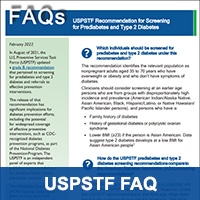The National DPP → Quality Metrics
Quality Metrics
In the health care industry’s drive towards value vs. volume, the importance of quality measures is increasingly vital to success. Quality metrics help ensure that organizational efforts at improving quality and decreasing costs are showing efficacy as determined by the measurement guidance.
This page is divided into seven sections (acronyms will be defined in the sections below):
- Development of Prediabetes Quality Measures
- Medicare MACRA QPP Improvement Activities
- NCQA Health Plan Accreditation: Population Health Management
- Health Equity Accreditation Programs: NCQA and URAC
- State Quality Strategies
- Current BMI-Focused Measures
- USPSTF Recommendations
Development of Prediabetes Quality Measures
The American Medical Association (AMA) convened a cross-specialty, multidisciplinary technical expert panel (TEP) in 2018 to identify and define new quality measures for prediabetes. The final measures proposed by the TEP represented the first measures in the U.S. intended to assist in the prevention of type 2 diabetes at the individual health care provider and group practice level. Researchers hope the quality measures proposed by the AMA may prompt greater accountability, action, and improvement towards achieving diabetes care goals.
The Core Quality Measures Collaborative (CQMC) has indicated the potential development of a prediabetes measure for the Accountable Care Organization (ACO) & Patient-Centered Medical Home (PCMH)/Primary Care Measures core quality measurements. CQMC is an organization of leaders from health plans, the Centers for Medicare & Medicaid Services (CMS), the National Quality Forum (NQF), physician organizations, employers, and consumers working together to reach a consensus and alignment on core performance measures across both the public and private sectors.
Additionally, a prediabetes measure could be developed through the CMS Medicare Access and CHIP Reauthorization Act (MACRA) Quality Measure Development Plan finalized under the MACRA final rule. An update and emphasis on preventive quality measures will encourage providers to focus more on diabetes prevention, rather than primarily managing costly patients after the development of diabetes.
Until prediabetes-focused quality measures are widely adopted, however, other metrics can be used to help ensure that prediabetes screening activities drive participation into programs leading to a decrease in population type 2 diabetes prevalence.
Medicare MACRA QPP Improvement Activities
On November 2, 2017, CMS released the 2018 Quality Payment Program (QPP) Final Rule which establishes required quality reporting for clinicians billing under Medicare Part B. The Merit-based Incentive Payment System (MIPS) determines Medicare payment adjustments and tracks clinicians in four performance categories: Quality, Cost, Promoting Interoperability, and Improvement Activities (IAs). The program determines Medicare payment adjustments. Using a compositive performance score, eligible clinicians may receive payment bonuses, payment penalties, or no payment adjustments.
Succeeding in MIPS Through Investment in Diabetes Prevention
AMA published a document, Disease Focus: Prediabetes, that outlines how implementation of a performance improvement initiative to prevent type 2 diabetes can help health care provider practices succeed in MIPS. The document outlines the different measures that relate to diabetes prevention in each MIPS performance category, potential MIPS score results, and related AMA resources that can help health care providers prevent diabetes while “checking all your MIPS boxes along the way.” While there is not currently any relevant prediabetes measures included in the Quality or Cost MIPS Performance Categories, there are relevant measures related to the Promoting Interoperability and Improvement Activities, which account for 25% and 15% of MIPS score totals, respectively. Clinicians required to report under MIPS and are involved in the National DPP lifestyle change program can utilize these measures when reporting under the Promoting Interoperability and Improvement Activities performance categories.
Relevant MIPS Performance Categories
Promoting Interoperability: Promoting interoperability is about using certified electronic health record technology (CEHRT) data in a meaningful way. The AMA suggests using clinically relevant information from CEHRT to identify patient-specific educational resources and provide access to those materials to at least one unique patient. This action maps to the “patient-specific education” measure. Practices can also incorporate patient-generated health data or data from a non-clinical setting into the CEHRT for at least one unique patient to map to the “patient-generated health data” measure.
Improvement Activities: This category of reporting is related to improving care delivery, access, and patient engagement. Processes can be implemented related to seven improvement activity measures:
- Chronic care and preventive care management for empaneled patients
- Glycemic screening services
- Glycemic referring services
- Practice improvement that engages community resources to help patient health goals
- Participating in Maintenance of Certification (MOC) part IV, a program for continuing medical education for providers (Part IV relates to “Improving Professional Practice and Quality Improvement”)
- Completion of AMA’s STEPS Forward program (a collection of interactive educational toolkits related to practice improvement and transformation), and
- Implementation of condition-specific chronic disease self-management support programs
NCQA Health Plan Accreditation: Population Health Management
Currently, twenty-seven states require health plans serving their Medicaid population to be accredited by the National Committee for Quality Assurance (NCQA) Health Plan Accreditation (HPA). Other states accept HPA as meeting broad accreditation requirements.
NCQA announced a new HPA category in 2018 titled Population Health Management (PHM). Within this PHM category, health plans first describe their strategy for addressing the needs of their members, then demonstrate effective execution of that strategy. The PHM category includes six standards, described below. The National DPP lifestyle change program could fit well into the PHM strategy of a well-functioning health plan, specifically related to PHM4, Wellness and Prevention. A managed care organization (MCO) may be able to use a National DPP lifestyle change program pilot to meet this standard.
- PHM1, PHM Strategy: Plans describe their comprehensive PHM strategy, including targeted populations, programs, services and activities offered to members, in addition to demonstrating that they provide basic program information to members and instructions for using program services.
- PHM 2, Population Identification: Plans integrate data to identify and assess the needs of members and connect them with appropriate programs or services.
- PHM 3, Delivery System Supports: Plans demonstrate how they support providers or practitioners in their delivery system, such as by providing data directly to ACOs or providing practice transformation support to budding PCMHs and demonstrate that they engage providers and practitioners in value-based payment arrangements.
- PHM 4, Wellness and Prevention: Plans identify members’ health risks and educate them about heathier lifestyles through evidence-based tools.
- PHM 5, Complex Case Management: Plans offer case management services to their most complex, highest-risk members.
- PHM 6, Population Health Management Impact: Plans conduct a comprehensive analysis of their PHM efforts, to determine the effectiveness of their strategy. Analysis includes measures related to clinical processes or outcome, member experience, and cost/utilization.
Health Equity Accreditation Programs: NCQA and URAC
National Committee for Quality Assurance (NCQA)
In response to increasing federal and state agency focus on establishing guidelines to identify and close gaps in unequal treatment, NCQA has established two optional accreditations related to improving health equity, NCQA’s Health Equity Accreditation and Health Equity Accreditation Plus. These accreditations are intended to support health care organizations in evaluating health equity locally and improving the health of the populations they serve. Participation in NCQA’s Health Equity Accreditation Programs, in tandem with the National DPP lifestyle change program, could further the understanding of diabetes-related disparities and seek to reduce their incidence.
The NCQA accreditations, described below offer a framework for helping health systems and other organizations continuously improve and prioritize health equity for their patients and their communities.
- Health Equity Accreditation: This program focuses on the foundations for establishing a health equity strategy. Participants will work towards building an internal culture that supports the overall organization’s ongoing health equity work, collecting data to support their strategy, developing language services and provider networks that are mindful of cultural and linguistic needs, and identifying opportunities to reduce health inequities and improve care.
- Health Equity Accreditation Plus. This program is intended for organizations with an established health equity strategy. Participants will focus on collecting data on community social risk factors and social needs, establishing mutually beneficial partnerships that support community-based organizations, identifying opportunities for patient engagement, and making progress to improve social need referral processes and the partnerships that make them possible.
Utilization Review Accreditation Committee (URAC)
URAC also offers a Health Equity Accreditation program with similar goals to NCQA. URAC’s program was developed in collaboration with the National Minority Quality Forum to allow health care organizations to highlight their commitments to addressing health disparities in the communities they serve. The accreditation is designed to promote integration of health equity principles, support industry initiatives to eliminate health disparities, and assure that high-risk racial and ethnic populations, as well as those with disabilities, receive optimal health care.
State Quality Strategies
Current Federal regulations require states to develop and maintain a quality strategy aimed at assessing and improving the quality of managed care services offered within a state. Each state who contracts with an MCO and/or prepaid inpatient health plan (PIHP) is required to gather feedback from key partners, including beneficiaries, provide a public comment period, and provide access to the final quality plan.
In the development of these state-specific quality plans, states make annual decisions on the development or selection of quality metrics that will best meet the need and improve health outcomes of their state’s Medicaid recipients. Processes vary state by state; however, there are potential opportunities to influence the development or selection process to include prevention measures like prediabetes measures.
Below are several state examples of the quality metric selection process. These summaries represent the best of the author’s knowledge at the time of publishing:
Louisiana
Louisiana formed the state Quality Committee to oversee and monitor the Medicaid program. MCOs are required to participate on the Quality Committee, are measured on a designated set of quality measures, and may be sanctioned for failing to meet minimum benchmarks. The Quality Committee advises the Louisiana Department of Health on best practices, provider relations, ongoing quality improvement measures, and recommendations for changes to Bayou Health’s structure as appropriate. The committee also includes representatives of both the Senate and House Health and Welfare committees.
Maryland
The State of Maryland is in the process of updating its previous Medicaid Quality Strategy. Maryland utilized the public comment period and collaborated across departments for subject matter expertise to develop a plan that includes the quality measures MCOs are required to report. Partner input has typically included Medicaid managed care plans, public health entities, and the state’s Medicaid Advisory Committee members. In the Draft Medicaid Quality Strategy 2022-2024 document, in the Quality Strategy Goals and Objectives section, the HealthChoice Diabetes Prevention Program is named as a program that has been put in place to address chronic diseases in HealthChoice members.
Minnesota
Beyond the federal quality strategy requirement, the Minnesota legislature passed a 2008 health reform law that requires the Commissioner of Health to establish a standardized set of quality measures for providers across the state. The standardized quality measure set is called the Minnesota Statewide Quality Reporting and Measurement System. Health plans may use the standardized measures and may not require providers to undertake reporting on measures outside of the system. Quality measure review occurs annually, and the process must include physicians.
New York
Every three years, the New York State Department of Health reviews the quality strategy and places it on their website for at least 30 days to gather public and partner comments on content and approach.
Oregon
For over two decades, Oregon has utilized the Health Evidence Review Commission (HERC) to evaluate quality measures and medical evidence. The HERC process relies on transparency and input through a series of public meetings organized to gather information from providers and the public to ensure the decisions made are in the best interest of the patients and taxpayers. The HERC develops and publicly provides a prioritized list of health services that guides legislative decisions, as well as evidence-based reports on topics that are of interest to payers, providers, and members of the public. In 2019, the HERC approved coverage for the National DPP lifestyle change program as a Medicaid benefit. This decision places the program on the HERC’s prioritized list of health services and requires Oregon Coordinated Care Organizations (CCOs) to reimburse eligible providers for offering the program.
Texas
In 2015, the Texas Health and Human Services Commission (HHSC) launched an initiative to conduct quarterly individual calls with each MCO managing Texas Medicaid patients. “The purpose of these quality calls is to maintain an interactive dialogue with MCOs on priority areas related to quality improvement and efficiency in the context of value-based purchasing roadmap designed by HHSC. The central paradigm of the dialogue is focused on measuring the value of healthcare provided to the state beneficiaries, within the healthcare delivery and payment reform led by HHSC.” Additionally, HHSC is required by state law to review and accept clinical initiative, quality, and efficiency improvement suggestions from state legislators, Commissioners of state health and human services agencies, the Medical Care Advisory Committee, the Physician Payment Advisory Committee, and the Electronic Health Information Exchange System Advisory Committee.
Current BMI-Focused Measures
Current quality measures have a strong focus on disease management rather than prevention, including type 2 diabetes management. Payers and providers participating in accreditation or recognition opportunities can look to quality measures focused on BMI to help in evaluating the success of the National DPP lifestyle change program. The following measure sets reflect the publicly available information related to BMI measures. There may be additional accreditation or recognition programs that include a BMI measure that can be accessed for a fee.
- Measure set: MIPS Quality Measures
- Primary measure steward: Centers for Medicare and Medicaid Services
- Measurement description: Preventive Care and Screening; BMI Screening and Follow-Up Plan: Percentage of patients aged 18 years and older with a BMI documented during the current encounter or within the previous twelve months AND who had a follow-up plan documented if most recent BMI was outside of normal parameters.
- Measure set: NCQA Patient Centered Medical Home Recognition Program
- Primary measure steward: Centers for Medicare and Medicaid Services
- Measure description: Same as above
States could also consider establishing measures that promote screening for potentially high-risk individuals and referrals of these individuals to disease management or prevention-based programs. The CMS measures “Closing the Referral Loop: Receipt of Specialist Report” or “Preventive Care and Screening: Screening for Depression and Follow-Up Plan” provide examples of a measures that can be utilized to enhance the referral process for at-risk individuals.
USPSTF Recommendations
The United States Preventive Services Task Force (USPSTF) is an independent panel of experts that publishes recommendations for evidence-based clinical preventive services. The Affordable Care Act requires a subset of health plans to cover items and services with a grade A or B USPSTF recommendation without cost-sharing for the relevant member. The counseling requirements referenced in the following recommendations can be met through coverage of the National DPP lifestyle change program. These recommendations will bring additional attention to prediabetes and may create momentum around the development of prediabetes measures as outlined above. For more information, see the USPSTF FAQ document developed by the National Association of Chronic Disease Directors (NACDD).
Prediabetes and Type 2 Diabetes: Screening
The USPSTF recommends screening for abnormal blood glucose in adults aged 35 to 70 years who have overweight or obesity. Clinicians should offer or refer patients with abnormal blood glucose to effective preventive interventions. (This recommendation applies to nonpregnant, overweight, or obese adults aged 35 to 70 years who are seen in primary care settings and do not have symptoms of diabetes. Persons who have a family history of diabetes, have a history of gestational diabetes or polycystic ovarian syndrome, or are members of certain racial/ethnic groups (American Indian/Alaska Native, Asian American, Black, Hispanic/Latino, or Native Hawaiian/Pacific Islander) may be at increased risk for diabetes at a younger age or at a lower body mass index. Clinicians should consider screening earlier in persons with 1 or more of these characteristics. Clinicians should also consider testing at a lower BMI in Asian American persons; data suggest that a BMI of 23 or greater may be an appropriate cut point.)
The USPSTF recommends offering or referring adults who have overweight or obesity and have additional cardiovascular disease (CVD) risk factors to intensive behavioral counseling interventions for CVD prevention. Impaired fasting glucose is listed as one such risk factor.
Coverage of the National DPP lifestyle change program is also indirectly related to two additional USPSTF grade A and B preventive services. These services reference National DPP lifestyle change program inclusion criteria.
Gestational Diabetes: Screening
The USPSTF recommends screening for gestational diabetes mellitus (GDM) in asymptomatic pregnant women after 24 weeks of gestation. Note: you cannot participate in the National DPP lifestyle change program if you are pregnant at the time of enrollment, but you are eligible if you were previously diagnosed with GDM (note that for Medicare DPP, a previous diagnosis of GDM is not sufficient for program eligibility).
Weight Loss to Prevent Obesity-Related Morbidity and Mortality in Adults: Behavioral Interventions
The USPSTF recommends screening all adults for obesity. Clinicians should offer or refer patients with a body mass index (BMI) of 30 kg/m2 or higher to intensive, multicomponent behavioral interventions. (This recommendation is currently being updated under the title of: Weight Loss to Prevent Obesity-Related Morbidity and Mortality in Adults: Behavioral and Pharmacotherapy Interventions.)










